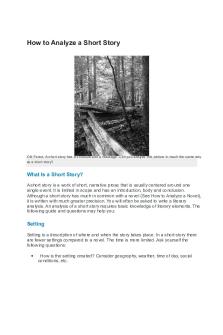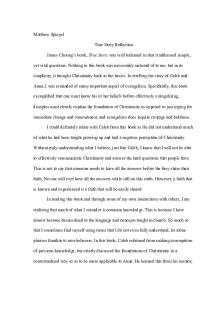How to Tell a True War Story PDF

| Title | How to Tell a True War Story |
|---|---|
| Author | jennifer burris |
| Course | English |
| Institution | University of South Carolina |
| Pages | 6 |
| File Size | 86.1 KB |
| File Type | |
| Total Downloads | 67 |
| Total Views | 139 |
Summary
Professor Smith
...
Description
Professor Smith English 101 10 December 2018 The Truth and The Untruth of a Good War Story In the excerpt ₁How to tell a True War Story found in The Carolina Reader , Tim O’Brien illustrates the uncertainty between the truth and untruth. Through the lens of the Vietnam War, O’Brien shares his experiences through storytelling methods instead of authentic happenings. The excerpt, “How to Tell a True Story,” starts with the story of Rat Kiley whom he represents the ₂amorality, sadness, and frustration that stems from a true war story. ³The untruth, or the storytelling truth, can reveal more of what actually happens to the characters than the actual happening truth does. These made up stories reflect more truth about the war itself, and each character in the excerpt are created to represent aspects of the war that couldn’t be told in simple words. All of O'Brien's writings show the amorality of a true war story. At the beginning of the excerpt, Curt Lemon, Rat Kiley’s close friend tragically dies by playing with a smoke grenade. Rat writes a letter to the soldier's sister expressing how good of a man and a better friend this man was. O’Brien writes, “Rat tells her what a great brother she had, how strack the guy was, a number one pal and comrade. A real soldier, Rat says…. Anyways it's a terrific letter, very personal and touching. Rat almost bawls writing it…. So what happens? Rat mails the letter. He waits two months. The dumb cooze never writes back. (O'Brien 273)” He did not receive a response, which is not something that the reader expects. We want a happy ending, but that
would not be in true war story fashion. In the end, all of these characters are made up, there's no Mitchell Sanders, no Curt Lemon, or Rat Kiley. But in a way, these men existed and played key roles in how O’Brien felt a true war story had to be told. O’Brien explains,” Yet even if it did happen- and maybe it did, anything’s possible- even then you know it can’t be true, because a true war story does not depend upon that kind of truth. Happeningness is irrelevant. A thing may happen and be a total lie; another thing may not happen and be truer than the truth” ₄ (O'Brien 282). In summary, a true war story is almost never true in exact happenings but true in the fact that only these words and stories can represent what these men were experiencing in Vietnam. O'Brien notes that you can tell a true war story if it makes you uncomfortable. In one particular story, six men are sent up into the mountains for a basic listening-post operation, where they have to spend a week in pure silence, “These guys get themselves deep in the bush, all camouflaged up, and they lie down and wait and that's all they do, nothing else, they lie there for seven straight days and just listen...They're pretty fried out by now, and one night they start hearing voices...All these different voices. Not human voices, though…They get on the radio and report enemy movement- a whole army, they say- and they order up the fire power…Later on, this fat bird colonel comes up and asks what the hell happened out there...I mean they spent six trillion dollars on firepower, and this fatass colonel wants answers he wants to know what the fuckin’ story is”₅(O'Brien 274-275). The moral of this story is that the men are astonished at what the colonel didn't hear, but the moral of the whole war story is that no one ever listens. The men in this story are driven so mad by the war, that they can't distinguish what was real and what was imagined. They can't explain what they heard because some things are too strange, or unbelievable. In another story, the men were up in the mountains and found a baby VC water
buffalo, Kiley offered it some beans but the baby didn't want it (O'Brien 279). ⁶O’Brien explains,” He ₇ [Kiley] stepped back and shot it through the front right knee… It wasn’t to kill, it was just to hurt. He put the rifle muzzle up against the mouth and shot the mouth away. Nobody said much. The whole platoon stood there watching, feeling all kinds of things, but there wasn't a great deal of pity for the baby water buffalo. Lemon was dead. Rat Kiley had lost his best friend in the world. Later in the week, he would write a long personal letter to the guy’s sister, who would not write back, but for now, it was a question of pain”₈(O'Brien 279). As crazy as it seems, the baby buffalo was still alive and it was nothing the men had ever seen before (O'Brien 279). O’Brien details,” Mitchell Sanders took out his yo-yo,‘Well, that’s Nam,’ he said,’ Garden of Evil. Over here, man, every sin’s real fresh and original.’ ”₉(O'Brien 280). In this quote, Kiley shot the baby water buffalo in all the places on its body where it would not be fatal. Because Kiley is in pain, and he has just lost his best friend to this war, he attacks the baby water buffalo to avenge the death of his friend, Curt Lemon. This animal was an easy target, it was completely helpless against Kiley's revengeful aggression. When it comes to war the truth can be ugly, grotesque, but also it can be beautiful. You can tell a true war story if it really makes your stomach believe its true (O'Brien 278). In the end, O'Brien highlights that this whole excerpt is not about the war at all, but everything else that goes into the war, love, and catastrophe, the truth and the untruth, and the people who do not listen.
’Brien explores the purpose and the rules to telling a In ₁₀The Things They Carried, O true war story. In the excerpt, ₁₁How to tell a true war story , he challenges the reader to think about if the truth exists, the idea of morality in a war setting, and the idea of right versus wrong. A lot unfolds in this segment of the book, but whether it has actually occurred is the question that
O’Brien leaves for the reader. If a war story does not represent the immortality, sadness, and beauty of the war, or make you wonder then it is not a true war story. A true war story should make you question where the truth in it is. Everything that O’Brien writes is true in some form, it can be truer if it portrays the truth that the soldiers are feeling whether than if it portrays what actually happened. O’Brien highlights the idea that the untruth, or the storytelling truth, can reveal more of what actually happens to the characters than the actual happening truth does.
₁ Changed The Things they Carried to How to tell a True War Story because that was the actual text that the paper was referring to. ₂ Spelling error, changed immortality to immorality. ³ Added more to the introduction to explain the distinction between the “storytelling truth” and the “happening truth” ₄MLA error, originally a quote was incorrectly cited in the text. ₅Another incorrect MLA citation error. ₆ More analysis to the quote provided. ₇ Changed the parentheses around a characters name to brackets. ₈Corrected an incorrect quote citation. ₉Another incorrect MLA citation error. ₁₀ Grammatical Error. ₁₁ Grammatical Error.
WORKS CITED O’Brien, Tim. “How to Tell a True War Story.” The Carolina Reader , Ethan J.H.Knight and Hannah Huber, Macmillan Learning, 2018, pg. 272-282....
Similar Free PDFs

How to Tell a True War Story
- 6 Pages

How to Analyze a Short Story
- 8 Pages

True Story Reflection
- 2 Pages

How To Write Your Success Story
- 5 Pages

How to write a Comment
- 1 Pages

How to write a comment
- 1 Pages

How to adress a judge
- 4 Pages

How to calibrate a thermometer
- 1 Pages

How to plan a business
- 14 Pages

How to Analyze a Case
- 19 Pages
Popular Institutions
- Tinajero National High School - Annex
- Politeknik Caltex Riau
- Yokohama City University
- SGT University
- University of Al-Qadisiyah
- Divine Word College of Vigan
- Techniek College Rotterdam
- Universidade de Santiago
- Universiti Teknologi MARA Cawangan Johor Kampus Pasir Gudang
- Poltekkes Kemenkes Yogyakarta
- Baguio City National High School
- Colegio san marcos
- preparatoria uno
- Centro de Bachillerato Tecnológico Industrial y de Servicios No. 107
- Dalian Maritime University
- Quang Trung Secondary School
- Colegio Tecnológico en Informática
- Corporación Regional de Educación Superior
- Grupo CEDVA
- Dar Al Uloom University
- Centro de Estudios Preuniversitarios de la Universidad Nacional de Ingeniería
- 上智大学
- Aakash International School, Nuna Majara
- San Felipe Neri Catholic School
- Kang Chiao International School - New Taipei City
- Misamis Occidental National High School
- Institución Educativa Escuela Normal Juan Ladrilleros
- Kolehiyo ng Pantukan
- Batanes State College
- Instituto Continental
- Sekolah Menengah Kejuruan Kesehatan Kaltara (Tarakan)
- Colegio de La Inmaculada Concepcion - Cebu





